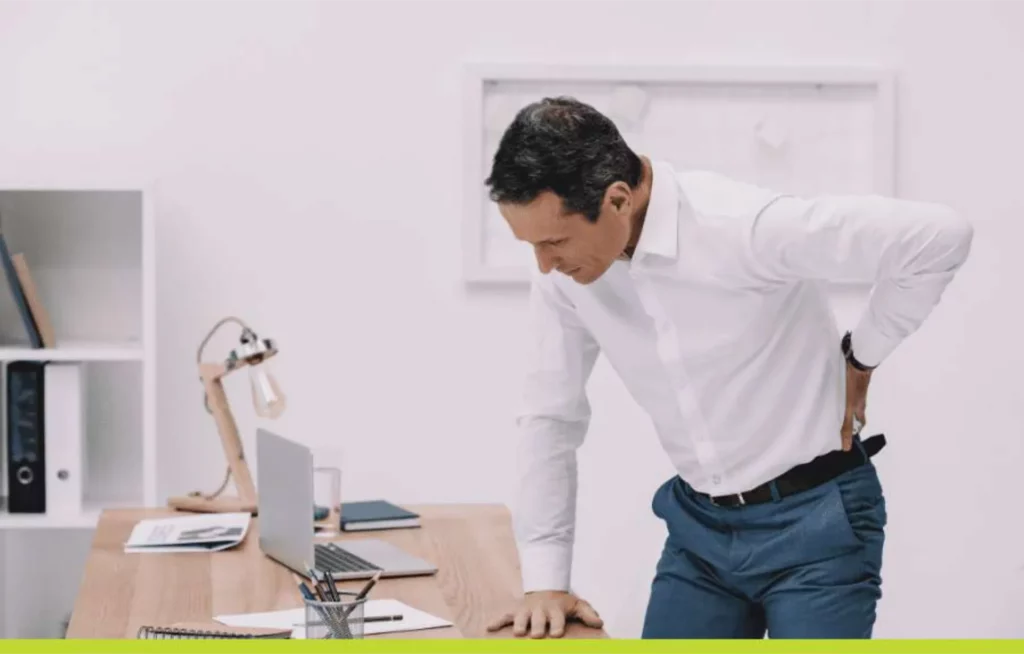Table of Contents
Why do I have hip pain sitting at the desk?
What does hip pain feel like?
How to prevent hip pain working from home?
What exercises can I do to relieve hip pain?
When should I go to a physio for hip pain?
Lower back/pelvis:
What does a physio do for hip pain?
Why do I have hip pain sitting at the desk?
With new working environments due to people working from home a lot more, we have seen an increase in people presenting with hip pain in the clinic.
Often hip pain can be nonspecific with no apparent cause.
Sitting at a desk places us in a flexed hip position for many hours of the day where the knee and hips are relatively parallel, causing the muscles at the front of our hip to become tight due to the static position.
The hip is inherently a mobile joint that should access all ranges of motion, from flexion, extension, rotation and side to side movements. We may lose these ranges of motion from sitting for long periods without moving, and the structures around the hip become tight, such as the muscles, tendons and ligaments as well as the hip joint itself.
This can lead to pain around the hip and groin as the muscles become shortened, aggravating the neural structures around the deep hip like the sciatic nerve. Previous lower back issues may also play a part in the sciatic nerve’s sensitivity from prolonged sitting.
What does hip pain feel like?
Hip pain may feel dull, achy or sharp depending on what is causing the pain itself to develop.
A limitation in range or impingement of the hip joint may lead to a feeling of stiffness in the hip itself or a dull ache on the outside of your hip.
A sharp pain that starts in the glutes around the hip that may or may not travel down the back of the leg can be caused by the sciatic nerve getting impinged deep in the hip.
Tight muscles around the hip can feel achy, and you may have tried to stretch these out.
Pain at the outside of the hip may be due to a gluteal tendon touching the outside of the hip, or sleeping on that side causes your pain. This is especially common in women where they lack stability in the hips and maybe do many yoga stretches. This may be aggravating the tendon issue as the tendon becomes compressed over the outside of the hip.
How to prevent hip pain working from home?
The best way to prevent hip pain when working from home is to take lots of breaks from your sitting position. This may be done by standing to work for short periods of time to give the hip flexors a chance to lengthen or going for short walks to wake up the hip muscles to prevent the feeling of a ‘’dead butt’’.
Changing a sitting position can also help you; sit on your cheekbones for some time, then switch to a more reclined position.
Use a thick pillow under the bum as it can take the pressure off your hips.
Movement is the best medicine, so we will show you some exercises you can do at home to relieve tightness and pain as well as firing up the muscles around the hips.
In summary, make sure you take regular breaks from sitting, try to change your position often and get out for a walk or do some movement and exercise throughout the day. Make sure you do some form of exercise daily.
If you can, take work calls walking around your house or even better walking outside. Also try to get out before or after work!
What exercises can I do to relieve hip pain?
These exercises aim to improve hip stability, mobility and flexibility of the muscles around the hips. Overall, this will help keep your hips happy.
Happy Hips = Happy person!
Exercise 1
Exercise 2
Exercises 3
Exercise 4
Exercise 5
When should I go to a physio for hip pain?
You should seek help for your hip pain if it is not resolving or improving over a few days.
People often take painkillers to relieve their pain but this often just masks the real issues and underlying cause.
Lower back/pelvis:
If pain and discomfort affects your daily life/work, affects your sleep, or is stopping you from carrying out your exercise routine, you should reach out to your physio to get assessed.
Often the hip itself may not be the issue as older injuries of the back, knees, or ankles can cause the hip to over or under load leading to weaknesses or tightness around the joint.
What does a physio do for hip pain?
Physiotherapy helps to relieve the pain and discomfort of the hip and the muscles around the hip that may be the cause.
The main benefit of physiotherapy is that it addresses the root cause of why the hip is getting aggravated by addressing faulty movement patterns, muscle weaknesses and mobility limitations.
All of our physios are also highly experienced in exercise prescription and education to get your body back ticking in its most effective and efficient way.
This article was written by Conor Tierney, Senior Athletic Therapist at ReSync Physiotherapy, and Hip and Groin Injury Specialist. We offer Free Consultation for people who are unsure if physiotherapy is right for them.

